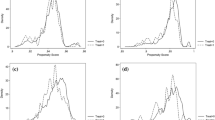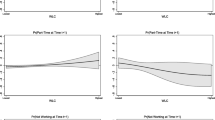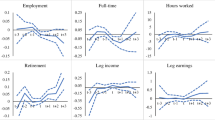Abstract
This paper investigates whether or not suffering a health shock, and becoming eligible for social security, have a joint effect on labor supply. Despite millions of people experiencing both of these events each year, no paper has focused exclusively on the joint effect that these events may have on work outcomes. This is surprising given that experiencing a health shock may impact on how a worker responds to becoming eligible for social security. With data from the Health and Retirement Study, I model weekly hours of work as a function of health shocks, social security eligibility, and their interaction. I find that this interaction leads to a 3–4 h reduction in weekly hours of work for men, but has no effect for women. The results are robust to using different work outcomes, age groups, health shock definitions, subgroups, as well as falsification and placebo tests. The results appear to be driven by men who would have had to return to work with impaired health. Policies that promote a more flexible work situation for older men may alleviate these problems in the future.


Similar content being viewed by others
Notes
More recently, a new strand of literature has emerged which focuses specifically on the effect of cancer on labor supply. Evidence from the U.S. [27,28,29,30,31,32,33,34,35], Europe [36,37,38,39,40], and elsewhere [41, 42], shows that cancer, like other health shocks, has generally been found to have a negative effect on labor supply.
Coile and Levine [9] interact Social Security eligibility ages (62, 63, and 64) with unemployment insurance, rather than health shocks, but the idea is the same.
In the HRS, the cancer variable is defined as cancer or a malignant tumor of any kind except skin cancer. The heart problem variable is defined as heart attack, coronary heart disease, angina, congestive heart failure, or other heart problems. Stroke is defined as stroke or transient ischemic attack. Lung disease is defined as chronic lung disease except asthma such as chronic bronchitis or emphysema.
The HRS [52] is sponsored by the National Institute on Aging (grant number NIA U01AG009740) and is conducted by the University of Michigan.
This transformation of wealth, W, is \(w = { \ln }\left( {W + \sqrt {W^2+ { 1}} } \right).\)
Finkelstein [53] uses this method with regards to a tax change, rather the Social Security eligibility, but the principle is the same.
References
Centers for Disease Control and Prevention.: Heart disease facts. http://www.cdc.gov/heartdisease/facts.htm (2017). Accessed 10 Dec 2018
Centers for Disease Control and Prevention.: Stroke. http://www.cdc.gov/stroke/ (2018). Accessed 10 Dec 2018
American Cancer Society.: Cancer facts and figures. https://www.cancer.org/content/dam/cancer-org/research/cancer-facts-and-statistics/annual-cancer-facts-and-figures/2018/cancer-facts-and-figures-2018.pdf (2018). Accessed 10 Dec 2018
Social Security Administration.: Fast facts & figures about social security. https://www.ssa.gov/policy/docs/chartbooks/fast_facts/2018/fast_facts18.html (2018). Accessed 10 Dec 2018
National Cancer Institute.: Relative survival rates by year of diagnosis, csr 1975–2015. https://seer.cancer.gov/csr/1975_2015/results_merged/topic_survival_by_year_dx.pdf (2015). Accessed 7 Apr 2019
Mehnert, A.: Employment and work-related issues in cancer survivors. Crit. Rev. Oncol. Hematol. 77(2), 109–130 (2011)
Centers for Disease Control and Prevention.: Summary health statistics for u.s. adults: National health interview survey, 2012. https://www.cdc.gov/nchs/data/series/sr_10/sr10_260.pdf (2012). Accessed 10 Dec 2018
Hullegie, P., Koning, P.: How disability insurance reforms change the consequences of health shocks on income and employment. J. Health Econ. 62, 134–146 (2018)
Coile, C.C., Levine, P.B.: Labor market shocks and retirement: do government programs matter? J. Public Econ. 91(10), 1902–1919 (2007)
Bound, J., Schoenbaum, M., Stinebrickner, T.R., Waidmann, T.: The dynamic effects of health on the labor force transitions of older workers. Labour Econ. 6(2), 179–202 (1999). (ISSN 09275371)
Coile, C.C.: Health shocks and couples’ labor supply decisions. National Bureau of Economic Research, working paper no. 10810 (2004)
Gupta, N.D., Kleinjans, K.J., Larsen, M.: The effect of a severe health shock on work behavior: evidence from different health care regimes. Soc. Sci. Med. 136–137, 44–51 (2015)
McClellan, M.: Health events, health insurance, and labor supply: evidence from the health and retirement survey. In: Wise, D.A. (ed.) Frontiers in the Economics of Aging, pp. 301–346. Chicago University Press, Chicago (1998)
Smith, J.P.: Consequences and predictors of new health events. In: Wise, D.A. (ed.) Analyses in the Economics of Aging, pp. 213–237. Chicago University Press, Chicago (2005)
Wu, S.: The effects of health events on the economic status of married couples. J. Hum. Resour. 38(1), 219–230 (2003)
Cai, L., Mavromaras, K., Oguzoglu, U.: The effects of health status and health shocks on hours worked. Health Econ. 23(5), 516–528 (2014)
Campolieti, M.: Disability and the labor force participation of older men in canada. Labour Econ. 9(3), 405–432 (2002). (ISSN 09275371)
Riphahn, R.T.: Income and employment effects of health shocks: a test case for the german welfare state. J. Popul. Econ. 12(3), 363–389 (1999)
Garcia-Gomez, P., van Kippersluis, H., O’Donnell, O., van Doorslaer, E.: Long-term and spillover effects of health shocks on employment and income. J. Hum. Resour. 48(4), 873–909 (2013)
Garcia-Gomez, P., Lopez-Nicolas, A.: Health shocks, employment and income in the Spanish labour market. Health Econ. 15(9), 997–1009 (2006)
Disney, R., Emmerson, C., Wakefield, M.: Ill health and retirement in Britain: a panel data-based analysis. J. Health Econ. 25(4), 621–649 (2006)
Garcia-Gomez, P., Jones, A.M., Rice, N.: Health effects on labour market exits and entries. Labour Econ. 17(1), 62–76 (2010)
Jones, A.M., Rice, N., Zantomio, F.: Acute health shocks and labour market outcomes. Health, Econometrics, and Data Group, working paper 16/04 (2016)
Lenhart, O.: The effects of health shocks on labor market outcomes: evidence from UK panel data. Eur. J. Health Econ. 20(1), 83–98 (2019)
Garcia-Gomez, P.: Institutions, health shocks and labour market outcomes across europe. J. Health Econ. 30(1), 200–213 (2011)
Trevisan, E., Zantomio, F.: The impact of acute health shocks on the labour supply of older workers: evidence from sixteen european countries. Labour Econ. 43, 171–185 (2016)
Bradley, C.J., Neumark, D., Bednarek, H.L., Schenk, M.: Short-term effects of breast cancer on labor market attachment: results from a longitudinal study. J. Health Econ. 24(1), 137–160 (2005)
Bradley, C.J., Neumark, D., Luo, Z., Bednarek, H., Schenk, M.: Employment outcomes of men treated for prostate cancer. J. Natl Cancer Inst. 97(13), 958–965 (2005)
Bradley, C.J., Neumark, D., Luo, Z., Bednarek, H.L.: Employment-contingent health insurance, illness, and labor supply of women: evidence from married women with breast cancer. Health Econ. 16(7), 719–737 (2007)
Bradley, C.J., Neumark, D., Motika, M.: The effects of health shocks on employment and health insurance: the role of employer-provided health insurance. Int. J. Health Care Finance Econ. 12(4), 253–267 (2012)
Bradley, C.J., Neumark, D., Barkowski, S.: Does employer-provided health insurance constrain labor supply adjustments to health shocks? New evidence on women diagnosed with breast cancer. J. Health Econ. 32(5), 833–849 (2013)
Candon, D.: The effect of cancer on the labor supply of men over the age of 65. Econ. Hum. Biol. 31, 184–199 (2018)
Moran, J.R., Short, P.F., Hollenbeak, C.S.: Long-term employment effects of surviving cancer. J. Health Econ. 30(3), 505–514 (2011)
Neumark, D., Bradley, C.J., Henry, M., Dahman, B.: Work continuation while treated for breast cancer. Ind. Labor Relat. Rev. 68(4), 916–954 (2015)
Short, P.F., Vasey, J.J., Moran, J.R.: Long-term effects of cancer survivorship on the employment of older workers. Health Serv. Res. 43(1), 193–210 (2008)
Candon, D.: The effects of cancer on older workers in the english labour market. Econ. Hum. Biol. 18, 74–84 (2015)
Heinesen, E., Kolodziejczyk, C.: Effects of breast and colorectal cancer on labour market outcomes–average effects and educational gradients. J. Health Econ. 32(6), 1028–1042 (2013)
Heinesen, E., Kolodziejczyk, C.: Labour market participation after breast cancer for employees from the private and public sectors: educational and sector gradients in the effect of cancer. Econ. Hum. Biol. 21, 33–55 (2016)
Taskila-Brandt, T., Martikainen, R., Virtanen, S.V., Pukkala, E., Hietanen, P., Lindbohm, M.-L.: The impact of education and occupation on the employment status of cancer survivors. Eur. J. Cancer 40(16), 2488–2493 (2004)
Torp, S., Nielsen, R.A., Gudbergsson, S.B., Fossa, S.D., Dahl, A.A.: Change in employment status of 5-year cancer survivors. Eur. J. Public Health 23(1), 116–122 (2013)
Jeon, S.-H.: The long-term effects of cancer on employment and earnings. Health Econ. 26(5), 671–684 (2017)
Lo, J.C.: Employment pathways of cancer survivors—analysis from administrative data. Eur. J. Health Econ. (2019). https://doi.org/10.1007/s10198-018-1025-8
Dano, A.M.: Road injuries and long-run effects on income and employment. Health Econ. 14(9), 955–970 (2005)
Halla, M., Zweimuller, M.: The effect of health on earnings: quasi-experimental evidence from commuting accidents. Labour Econ. 24, 23–38 (2013)
Gustman, A.L., Steinmeier, T.L.: A structural retirement model. Econometrica 54(3), 555–584 (1986)
Gustman, A.L., Steinmeier, T.L.: The social security early entitlement age in a structural model of retirement and wealth. J. Public Econ. 89(2–3), 441–463 (2005)
Ferreira, P.C., dos Santos, M.R.: The effect of social security, health, demography and technology on retirement. Rev. Econ. Dyn. 16(2), 350–370 (2013)
Blau, D.M.: Labor force dynamics of older men. Econometrica 62(1), 117–156 (1994)
Krueger, A.B., Pischke, J.S.: The effect of social security on labor supply: a cohort analysis of the notch generation. J. Labor Econ. 10(4), 412–437 (1992)
Mastrobuoni, G.: Labor supply effects of the recent social security benefit cuts: empirical estimates using cohort discontinuities. J. Public Econ. 93(11–12), 1224–1233 (2009)
Coile, C.C.: Economic determinants of workers’ retirement decisions. J. Econ. Surv. 29(4), 830–853 (2015)
Health and Retirement Study.: RAND version N, public use dataset. Produced and distributed by the University of Michigan with funding from the National Institute on Aging (grant number NIA U01AG009740). Ann Arbor (2015)
Finkelstein, A.: The effect of tax subsidies to employer-provided supplementary health insurance: evidence from canada. J. Public Econ. 84(3), 305–339 (2002)
Schultz, A.B., Chen, C.-Y., Edington, D.W.: The cost and impact of health conditions on presenteeism to employers. Pharmacoeconomics 27(5), 365–378 (2009)
Skagen, K., Collins, A.M.: The consequences of sickness presenteeism on health and wellbeing over time: a systematic review. Soc. Sci. Med. 161, 169–177 (2016)
Pichler, S., Ziebarth, N.R.: The pros and cons of sick pay schemes: testing for contagious presenteeism and noncontagious absenteeism behavior. J. Public Econ. 156, 14–33 (2017)
Jones, M.K., Latreille, P.L., Sloane, P.J.: Job anxiety, work- related psychological illness and workplace performance. Br. J. Ind. Relat. 54(4), 742–767 (2015). https://doi.org/10.1111/bjir.12159
Acknowledgements
I wish to thank Kevin Denny, Christopher Jepsen, Kanika Kapur, Maarten Lindeboom, David Madden, Andrea Weber, two anonymous referees, and seminar participants at the 31st annual European Society for Population Economics and 12th biennial International Health Economics Association conferences for helpful comments.
Funding
This research was funded by the Irish Research Council, who had no involvement in the conduct of the research.
Author information
Authors and Affiliations
Corresponding author
Additional information
Publisher's Note
Springer Nature remains neutral with regard to jurisdictional claims in published maps and institutional affiliations.
Data: The data used in this paper are from the Health and Retirement Study, a publicly available data set. The computer code used to generate the results is available on request.
Previous version: An earlier and less developed version of this manuscript circulated under the title “Are cancer survivors who are eligible for social security more likely to retire than healthy workers? Evidence from difference-in-differences”. It was not presented at any conferences or seminars. A copy can be made available on request.
Rights and permissions
About this article
Cite this article
Candon, D. The joint effect of health shocks and eligibility for social security on labor supply. Eur J Health Econ 20, 969–988 (2019). https://doi.org/10.1007/s10198-019-01053-2
Received:
Accepted:
Published:
Issue Date:
DOI: https://doi.org/10.1007/s10198-019-01053-2




